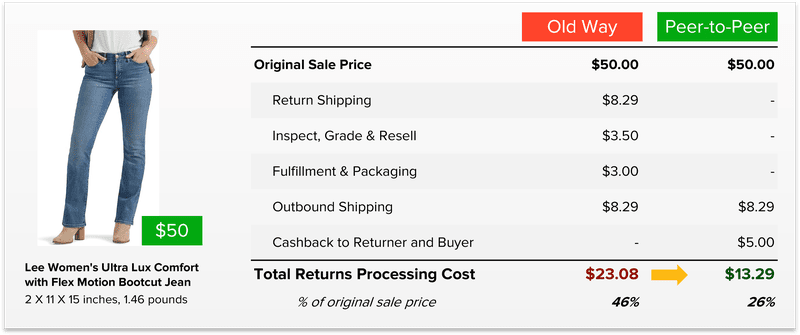Navigating Shipping Costs: A Comprehensive Guide for Online Retailers

Last updated on March 26, 2025

In the fast-paced world of online retail, shipping isn’t just about moving a package from point A to point B. It’s the bridge between your business and your customers; the final step in a purchasing journey that shapes customer satisfaction, impacts repeat business, and can even make or break a sale. The reality is that shipping costs are more than just numbers on a balance sheet; they require a well-thought-out strategy that balances affordability, efficiency, and customer expectations.
Why Shipping Costs Matter
Shipping is often the last impression your business leaves on a customer, and it can be the deciding factor in whether they return to make another purchase. It can even determine whether the first purchase is made at all. Research consistently shows that high shipping costs or unexpected fees are one of the top reasons for cart abandonment. In fact, nearly half of all abandoned carts are due to unexpected fees, such as shipping expenses. That’s a significant loss of potential revenue! Developing a clear and cost-effective shipping strategy is crucial to keeping customers happy and ensuring they complete their purchases.
Understanding the Factors That Drive Shipping Costs
Shipping costs aren’t arbitrary; while they may seem to change at random, they’re determined by several key factors that every retailer can and should understand to manage expenses effectively:
Shipping Carrier
Each major shipping carrier has unique pricing structures, restrictions, and services, so choosing the right one depends on your business needs. Among major carriers, USPS is ideal for small packages and lightweight items, with very affordable domestic rates and flat-rate options. For overnight/guaranteed delivery shipments, freight or heavy parcels, or shipments requiring high levels of tracking accuracy, however, USPS will not generally be the best solution.
UPS and FedEx excel with larger and heavier shipments, as well as for shipments that require expedited/guaranteed delivery options or those that require overnight delivery. As the two major players in domestic shipping outside of USPS, they offer more custom pricing solutions and expanded services for sellers that need them.
DHL is at its best in the arena of international shipping, where it can leverage its exceptional international coverage and expertise in customs clearance to provide a consistently low-cost solution for a complex shipping problem. DHL is a less attractive solution, however, when competing with UPS or FedEx for domestic shipments that must be delivered on tight deadlines with a high degree of tracking accuracy.
Package Weight and Size
Weight and size are the key variables when determining shipping costs. Heavier packages cost more to ship, but many retailers realize too late that size is just as important. Carriers use a pricing model called dimensional weight pricing, which means they calculate a “dimensional weight” based on the physical dimensions of the parcel (length x width x height / DIM factor). Carriers adopted dimensional weight pricing to more accurately reflect the costs of transporting packages. The more space a package takes up, the less room there is for other packages. For shipping carriers, this means they can carry fewer goods, which ultimately reduces their efficiency and increases costs.
This means a lightweight but bulky item could cost more to ship than a denser, heavier one. Sellers should pay close attention to the dimensions of their packages and the specific dim factors used by carriers for the service levels required, in order to avoid paying unnecessarily high shipping fees.
Shipping Distance and Zones
It is intuitive that the farther a package has to travel, the more expensive it will be to ship. To facilitate pricing for shipments going different distances, carriers use a concept of shipping “zones” to measure how far from the sender address a shipment has to go. For US domestic shipments, Zone 1 represents a package traveling a short distance from its origin, and Zone 8 represents the farthest a package can be sent in the continental United States. As might be expected, a higher zone designation increases the cost of a shipment. You can measure the exact zone between two zip codes using this zone chart from USPS.
USPS Zone | Approximate Shipment Distance (Miles) |
|---|---|
Zone 1 | 1 to 50 |
Zone 2 | 51 to 150 |
Zone 3 | 151 to 300 |
Zone 4 | 301 to 600 |
Zone 5 | 601 to 1,000 |
Zone 6 | 1,001 to 1,400 |
Zone 7 | 1,401 to 1,800 |
Zone 8 | 1,801+ |
International shipping introduces an even greater level of complexity with customs fees, import taxes, and varying regulations that must be complied with. Failing to account for the complexities of international shipping can lead to costly delays, shipment rejections, and even legal action, so sellers should pay scrupulous attention to all fees and requirements. If you’re shipping internationally, consider:
- Researching country-specific shipping rules and import taxes
- Using carriers that specialize in international shipping
- Offering customers an estimated total cost (including duties) at checkout to prevent surprises
Location and Geography
The delivery area plays a crucial role in determining shipping costs, as carriers factor in distance, accessibility, and regional demand when setting prices. Shipping to urban areas with well-established logistics networks is generally more cost-effective due to the high volume of deliveries and proximity to distribution centers.
In contrast, rural or remote locations often incur higher fees due to longer transit distances, lower delivery frequency, and additional fuel or labor costs. Carriers may impose surcharges (called Extended Delivery Area Surcharges, or Remote Area Surcharges for certain locations) for areas that require special handling, such as islands, mountainous regions, or locations with limited road access, further increasing the overall shipping expense. UPS provides a sheet containing all the zip codes that have special classifications such as Delivery Area Surcharge, Remote, and more.
For the same reasons, shipping to residential addresses is generally more expensive than shipping to commercial locations. Commercial addresses, such as offices, warehouses, and retail stores, are typically located in areas with high delivery volumes, making them easier and more cost-effective for carriers to service. These locations often have designated loading docks, business hours that align with delivery schedules, and multiple shipments being delivered at once, reducing the overall cost per package. As a result, shipping to commercial addresses is generally cheaper, and some carriers offer discounted rates for business deliveries. In addition, a residential tag allows for weekend delivery, while packages to commercial addresses are almost never delivered on a weekend.
Delivery Speed and Service Level
The faster a package needs to arrive, the higher the shipping cost. Expedited and overnight shipping services come at a premium and, while customers often appreciate faster delivery, absorbing the cost of fast delivery can quickly eat into profits. Most retailers offer multiple shipping speed options so customers can choose between affordability and convenience, alienating fewer potential buyers than a one-size-fits-all approach.
Package Value and Insurance
When selling high-value products, it may be necessary to invest in shipping insurance to protect against loss, damage, or theft. While this adds an extra cost, it’s a safeguard that can save time and resources by avoiding expensive customer service disputes and chargebacks. For items such as jewelry or consumer electronics, shipping insurance is a must.
Shipping Adjustments and Surcharges
One underestimated driver of unexpected shipping costs are shipping adjustments and surcharges added to a shipment after a label is purchased. This happens most often when shippers incorrectly enter information related to the shipment, such as size or weight, so that the initial price paid for a label does not accurately reflect the cost of the shipment. Carriers will add the difference as an additional “adjustment” cost for the shipment in question, usually along with a service fee.
Additional Handling Surcharges from UPS and FedEx are extra fees applied to shipments that require special handling due to their size, weight, or packaging. These surcharges help carriers cover the additional labor, equipment, and logistics needed to move non-standard packages safely and efficiently. They typically apply to:
- Weight-Based Handling: Packages exceeding a certain weight threshold (e.g., over 50 lbs for UPS, over 50 lbs for FedEx) incur additional handling fees.
- Dimension-Based Handling: Items exceeding specific length or width limits (e.g., over 48 inches on the longest side for UPS or FedEx) are subject to surcharges.
- Packaging-Based Handling: Non-standard packaging, such as irregularly shaped, cylindrical, or loosely wrapped items, may trigger additional handling fees. This includes items like tires, buckets, or unboxed goods.
To minimize these surcharges, sellers should plan strategically.
Strategies to Reduce Shipping Costs
Shipping expenses don’t have to cut into your profits. One of the most important ways shippers can reduce costs is by negotiating with their carriers for improved rates. When negotiating, it is imperative that sellers have a sound understanding of their shipping volume and profile, to understand exactly what benefit they would get and what costs may be hidden in an otherwise-attractive rate schedule.
For instance, sellers with large but lightweight products should negotiate for things like discounts on additional handling fees, variances on the dimensions of shipments that meet the threshold for such fees, and/or a higher DIM weight divisor to ensure that DIM weights more closely reflect the physical weight of the package. Even smaller businesses can negotiate better rates with carriers, especially if you have a steady shipping volume. Many carriers offer discounted rates for business accounts, so don’t be afraid to ask.
Other effective ways to keep costs under control include:
- Optimizing Your Packaging: Using the smallest and most efficient packaging possible helps reduce dimensional weight costs. Consider using poly mailers instead of boxes when shipping non-fragile items to save space and costs.
- Verifying Shipping Addresses: Incorrect addresses can result in costly delivery failures and re-shipping fees. Implementing an address verification tool at checkout can help prevent these issues before they happen.
- Leveraging Shipping Software: Platforms like Shopify Shipping, ShipStation, and EasyPost can help streamline your shipping process, offering discounts on carrier rates, automating label printing, and providing real-time tracking for customers.
Balancing Cost with Customer Experience
Finding the right balance between affordability and customer satisfaction is key. Some retailers choose to partially absorb shipping costs to keep fees low, while others set strategic free shipping thresholds to encourage higher spending. Offering multiple shipping options gives customers flexibility, allowing them to decide whether they want to save money or receive their order faster.
The essential consideration for sellers is that, while providing free shipping can be costly, in the Age of Amazon consumers have come to expect fast, free shipping as a basic expectation. As noted above, unexpected shipping costs can harm conversion rates. Sellers who can afford to do so should prioritize finding a way to affordably provide the shipping experience consumers have come to expect, as doing so both increases the volume of new customers and the average lifetime value of their purchases.
Conclusion
Shipping strategy isn’t a one-and-done decision—it requires regular assessment. Monitor your shipping data, track costs, and gather customer feedback to identify opportunities for improvement. By understanding the key cost factors, choosing the right pricing model, leveraging technology, and continuously optimizing your process, you can turn shipping from a potential pain point into a seamless and profitable part of your business.
In e-commerce, the way you deliver products speaks volumes about your brand. A well-executed shipping strategy not only saves you money but also builds trust and loyalty with your customers, ensuring they return for future purchases.

Up to 64% Lower Returns Processing Cost


 10 minutes
10 minutes